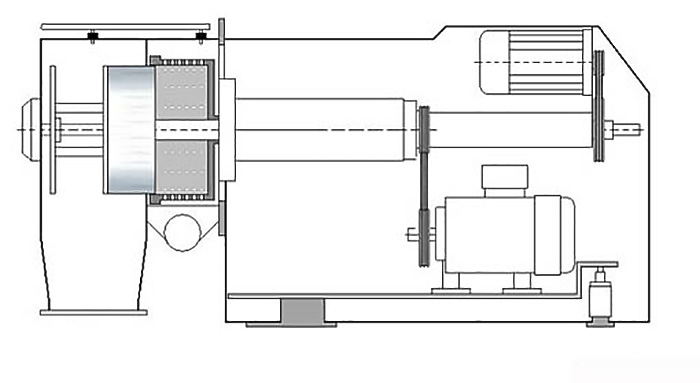Inverting filter – the wrong concept ?
In the pharmaceutical industry, the sieve basket tends to be the preferred choice for dehumidification. The drum shell is perforated at defined intervals, which ensures short flow paths of the separated filtrate through the drum shell, so that hardly any solids can deposit on the drum shell even during the spin-off of the filtrate. In addition, it is possible to clean the filter cloth with almost no residual layer.
 N2 gas is blown into the bores of the basket shell at a pressure of 6-7 bar by means of nozzles arranged on the rear of the basket shell, whereby the residual layer breaks and separates from the cloth. The deposited base layer residues are diverted into the product discharge and removed. It is beneficial that the screen basket rotates only moderately. In the more efficient Krettek backwash concept, the rotor shell is fully developed and the filtrate separated via the filter medium runs through the unperforated rotor shell through the bores connecting the two process chambers into the backwash chamber. The different configurations of the screen basket and the backwash rotor not only determine the process, but also influence the centrifugal force that can be achieved during centrifugation.
N2 gas is blown into the bores of the basket shell at a pressure of 6-7 bar by means of nozzles arranged on the rear of the basket shell, whereby the residual layer breaks and separates from the cloth. The deposited base layer residues are diverted into the product discharge and removed. It is beneficial that the screen basket rotates only moderately. In the more efficient Krettek backwash concept, the rotor shell is fully developed and the filtrate separated via the filter medium runs through the unperforated rotor shell through the bores connecting the two process chambers into the backwash chamber. The different configurations of the screen basket and the backwash rotor not only determine the process, but also influence the centrifugal force that can be achieved during centrifugation.
The perforation of the screen drum weakens the shell. This means that the screen drum cannot be operated with the same or similar dimensions at the same high speeds as the unperforated backwash rotors. Nevertheless, it was possible to increase the spin factor of the Krettek screen basket by optimized design. In this context, the residue-free cleanability required by the CIP guidelines also requires absolute cleanliness of the rear side of the basket or rotor. This presupposes that the rear basket base must be freely visible. If the hinged housing is identical, the length of the basket or rotor cannot be the same.
The extremely slim design deliberately chosen for lower cleanliness requirements cannot therefore be achieved with pharmaceutical centrifuges. In addition, the two designs also differ in the support of the cloth. While in the screening basket the cloth is integrated with a drainage element, in the backwash rotor it is supported on the slotted bridge screen.
With its protruding bridges, this ensures an annular gap between the filter cloth and the rotor wall through which the filtrate can flow into the backwash chamber. The elimination of known dovetail grooves to secure the filter cloths also eliminates existing sources of germination and contamination. This is completely different with the well-known inverting filter centrifuge designs.

Sectional drawing of the inverting filter centrifuge in discharge position
Depending on the system, the filtration basket is designed in several parts. In order to empty the basket, the filter cloth must be turned upside down while performing not inconsiderable flexing work. As a result, a large number of seals are subjected not only to rotational but also to translational loads, which causes increased abrasion and product contamination.
Due to the design, inverting filter baskets must be screwable. This inevitably leads to an undesirable number of gaps, undercuts and dead spaces. Also a visual inspection without dismantling the inverting filter centrifuge in the area of the basket bottom as well as a translatorically impaired hollow shaft is not possible.

